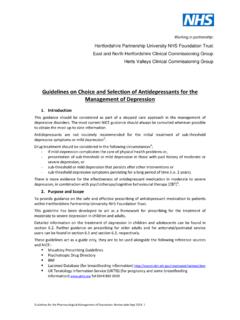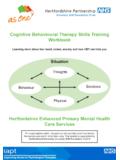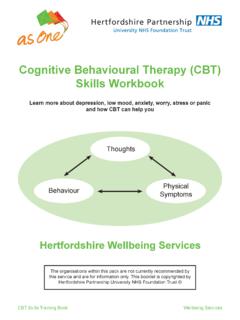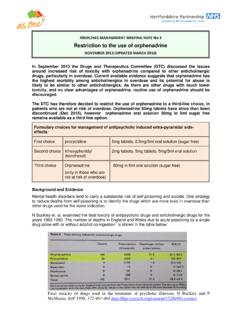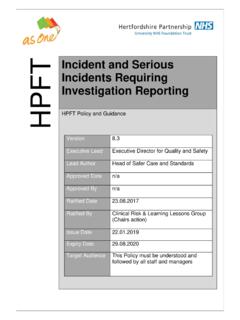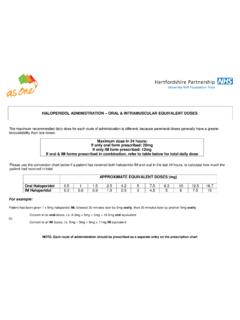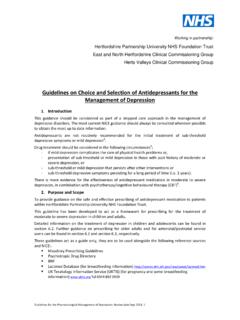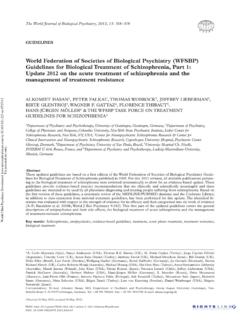Transcription of Guidelines on Choice and Selection of …
1 Working in partnership: Hertfordshire Partnership University NHS Foundation Trust East and North Hertfordshire Clinical Commissioning Group Herts Valleys Clinical Commissioning Group Guidelines on Choice and Selection of Antipsychotics for the management of psychosis and schizophrenia in Adults Introduction Antipsychotics are the mainstay of the pharmacological management of schizophrenia . They are used to reduce symptoms in the acute psychotic phase of the illness and also as maintenance treatment to reduce the likelihood of psychotic relapses in stable patients.
2 The National Institute of Health and Care Excellence (NICE) Clinical Guidelines 178 for psychosis and schizophrenia in Adults recommends that an oral antipsychotic be offered to individuals with newly diagnosed schizophrenia in conjunction with psychological interventions. The aim of treatment is to improve social and cognitive functioning and patients will often require long term treatment with antipsychotic medication. The efficacy of currently available antipsychotic agents in the treatment of schizophrenia is broadly similar1,2 (with the exception of clozapine's greater efficacy in treatment-resistant patients)1,2.
3 Individual patient response can however vary. Antipsychotics also have important differences in the side-effects they cause. Patients differ in the side-effects they experience and the side-effects they are willing or not willing to tolerate. Antipsychotics are most effective in ameliorating positive symptoms of schizophrenia , but less effective in treating negative and cognitive symptoms. Purpose and scope To provide guidance on the Choice and Selection of antipsychotic medication for the management of psychosis and schizophrenia within Hertfordshire Partnership University NHS Foundation Trust (HPFT).
4 These Guidelines cover both first episode psychosis and subsequent episodes and are based primarily on NICE CG 178 psychosis and schizophrenia in adults. These Guidelines do not cover the management of psychoses and schizophrenia in: Children and adolescents NICE CG 155 psychosis and schizophrenia in children and young people Pregnancy and lactation NICE CG 192 Antenatal & postnatal mental health: clinical management and service. They also do not cover the use of antipsychotics in management of other disorders; please consult relevant national and/or local Guidelines or contact Pharmacy for specific advice.
5 Guidelines on Choice and Selection of Antipsychotics for the management of psychosis and schizophrenia in Adults. Review date Feb 2019. 1. This document does not aim to provide full prescribing Guidelines and other relevant sources of information (see below) and HPFT policies should be consulted for guidance on the safe and effective prescribing of antipsychotics. This is in addition to the above NICE CIinical Guidelines : British National Formulary (BNF). Summary of product characteristics (SPC). Maudsley Prescribing Guidelines in Psychiatry Psychotropic Drug Directory Evidence-based Guidelines for the pharmacological treatment of schizophrenia : recommendations from the British Association for Psychopharmacology HPFT Clozapine Policy HPFT High Dose antipsychotic Therapy (HDAT) Guidelines HPFT Physical Health Policy HPFT Rapid Tranquillisation Policy HPFT management of Behavioural and Psychological Symptoms of Dementia HPFT Medicines Adherence Policy General principles 3, 4.
6 With the exception of clozapine, the efficacy of all antipsychotics is very similar and the initial Choice should be based on several factors. These are listed under Choice of antipsychotic . below. [Note: Clozapine is indicated in treatment-resistant schizophrenia and should only be used when there has been a lack of satisfactory clinical improvement despite the use of adequate doses of at least two different antipsychotic agents, including an atypical antipsychotic agent, prescribed for adequate duration. Clozapine is also licensed for use in psychotic disorders occurring during the course of Parkinson's disease, in cases where standard treatment has failed].
7 An individual trial of the antipsychotic of Choice should be conducted in terms of dosage, duration (up to 4 weeks at optimum dosage) and medication adherence. (The optimum dose is the dose that will produce the desired effect with minimum undesirable side-effects). Record the indications and expected benefits and risks of oral antipsychotic medication. Also document the expected time for a change in symptoms and emergence of side-effects. Discuss and record the side-effects that the person is most willing to tolerate. At the start of treatment, use doses at the lower end of the licensed range and slowly titrate upwards according to response and tolerability.
8 Assess response (at optimum dosage) over 2. to 3 weeks, and if some response continue for at least 4 weeks before considering a change of drug. See treatment algorithm on page 4. The lowest effective dose should be used. Doses should be within the maximum BNF or SPC dose limits. Lower doses are particularly appropriate for negative symptoms and first episode psychosis . Record the rationale for continuing, changing or stopping medication, and the effects of such changes. Communicate this to the GP especially when prescribing responsibility is to be transferred to primary care.
9 Guidelines on Choice and Selection of Antipsychotics for the management of psychosis and schizophrenia in Adults. Review date Feb 2019. 2. Current evidence does not justify the routine use of High Dose antipsychotic Therapy (HDAT). Justify and record the reasons for prescribing dosages outside the range given in the BNF or SPC. Refer to HPFT HDAT Guidelines . Patients should only be treated with ONE regular antipsychotic at a time except in exceptional circumstances ( clozapine augmentation or when cross-tapering medication). antipsychotic polypharmacy should be avoided due to increased risk of adverse effects such as extrapyramidal side effects (EPSEs), QT interval prolongation and sudden cardiac death5.
10 Oral and parenteral doses of the same antipsychotic should be prescribed separately as they can vary in bioavailability. As required prescriptions should be reviewed regularly, ideally weekly, or as appropriate for clinical indication, frequency of administration, therapeutic benefits and side-effects. Prescriptions that are no longer required should be cancelled and doses of regular antipsychotics adjusted accordingly where appropriate. Check whether when required prescriptions have led to a dosage above the maximum daily dose specified in the BNF or SPC. Response to treatment and side-effects experienced should be assessed using validated rating scales and recorded in the electronic patient record (EPR).
